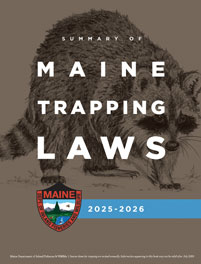Home → Hunting & Trapping → Trapping → Laws & Rules → Definitions and Descriptions
Definitions and Descriptions

Bait
Bait is defined as animal matter including meat, skin, bones, feathers, hair or any other solid substance that used to be part of an animal. This includes live or dead fish. Bait does not include animal droppings (scat), urine, or animals, dead or alive, held in a trap as the result of lawful trapping activity.
Beaver Dam
A dam built by a beaver to provide a pond as protection against predators and provide easy access to food during the winter. The Department, for enforcement purposes, has modified its definition of a “beaver dam”. A beaver dam does not include the remains of an inactive or breached beaver dam that is in disrepair and is no longer being maintained by beaver.
Beaver House
The term beaver house shall be interpreted to include any cavity which is capped by beaver with mud and sticks, including a cavity in the bank. Holes in the bank not capped with mud and sticks shall not be considered beaver houses.
Built-up Portion of a Town
The compact or built-up portion of a municipality is the territory contiguous to a way that is built up with structures situated less than 150 feet apart for a distance of at least 1/4 of a mile.
Catch Circle
Drowning Set
A drowning set is a trap that is set completely under water and rigged in such a way as to reasonably ensure the drowning of any species of trapped furbearer that would reasonably be expected to visit the set location and be held in the type of trap used at the set, this is also known as a submersion set.
Note: You are allowed to trap in shallow water where a trapped animal is not likely to drown, but traps set in this manner are not considered to be drowning sets and are not allowed within 1/2 mile of the built up section of a city or town. For enforcement and information purposes, all drowning sets for beaver and muskrat during January and February will be considered "under ice drowning sets" as far as trap tending requirements are concerned.
Muskrat Den
A muskrat den is any cavity, which is capped by muskrats with vegetative matter including but not limited to hollow stumps and bank cavities. Holes in the bank not capped with vegetative matter shall not be considered muskrat dens.
Trap
A trap is any device which is made to catch or hold animals. There are many types of traps, but those which you are allowed to use to trap wild animals in Maine under the rules explained in the following pages are:
- Foothold traps (See regulations for specific types of traps)
- Enclosed foothold traps (See regulations for specific types of traps)
- Killer-type traps of the body-gripping variety, including spring-type traps (See killer-type (conibear) trap rules)
- Cage-type live traps (See regulations for specific types of traps)
- Colony traps (See regulations for specific types of traps)
- Cable devices (See regulations for specific types of traps)
- Wooden-based rat traps are legal for weasel and red squirrel (See regulations for specific types of traps)
Trapping
Any of the following actions are considered trapping:
- Setting one or more traps anywhere in the fields, forests or waters of the State
- Tending or visiting a trap which has been set in the fields, forests or waters of the State
- Killing an animal which is being held in a trap
- Removing an animal from a trap
- Assisting another person in doing any of these things
Tributary
Means a brook, stream or river flowing directly or indirectly into a lake, pond or another brook, stream or river. A lake or great pond shall not be construed to mean tributary. The tributary to a great pond shall not be considered a tributary to the outlet of that great pond.
Visible Attractor
Means an object hung or placed at a trap site location that serves as a visual cue to attract an animal to the trap. Visible attractor includes, but is not limited to, CD-disc, tin can cover, foil, tinsel, feathers, bones, fur, mechanical devices, or any like items. Fruits or vegetables used for muskrat trapping, urine, and animal droppings (scat) are not considered a visible attractor. Small pieces of flagging can be used to mark trap site locations.